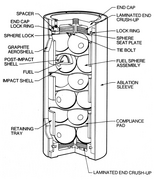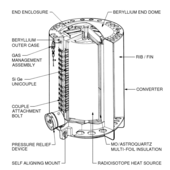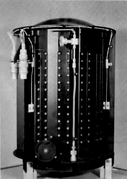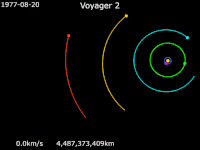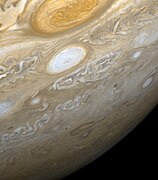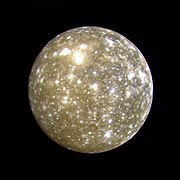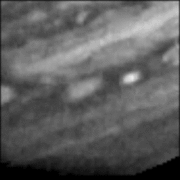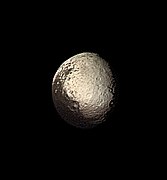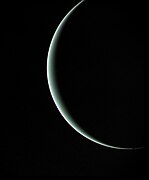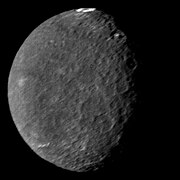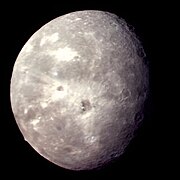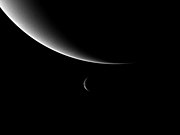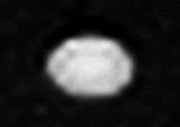Voyager 2 is a space probe launched by NASA on August 20, 1977, it has been sending scientific data to Earth for 46 years, 8 months, 6 days, making it the oldest active space probe. It was launched 16 days before its twin Voyager 1. Its primary mission was to study the outer planets and its extended mission is to study interstellar space beyond the Sun's heliosphere.
 Model of the Voyager spacecraft | |
| Mission type | Planetary exploration |
|---|---|
| Operator | NASA / JPL[1] |
| COSPAR ID | 1977-076A[2] |
| SATCAT no. | 10271[2] |
| Website | voyager |
| Mission duration |
|
| Spacecraft properties | |
| Manufacturer | Jet Propulsion Laboratory |
| Launch mass | 721.9 kilograms (1,592 lb)[3] |
| Power | 470 watts (at launch) |
| Start of mission | |
| Launch date | August 20, 1977, 14:29:00 UTC |
| Rocket | Titan IIIE |
| Launch site | Cape Canaveral LC-41 |
| Flyby of Jupiter | |
| Closest approach | July 9, 1979 |
| Distance | 570,000 kilometers (350,000 mi) |
| Flyby of Saturn | |
| Closest approach | August 26, 1981 |
| Distance | 101,000 km (63,000 mi) |
| Flyby of Uranus | |
| Closest approach | January 24, 1986 |
| Distance | 81,500 km (50,600 mi) |
| Flyby of Neptune | |
| Closest approach | August 25, 1989 |
| Distance | 4,951 km (3,076 mi) |
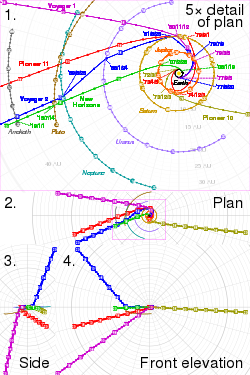
Plot 1 is viewed from the north ecliptic pole, to scale.
Plots 2 to 4 are third-angle projections at 20% scale.
In the SVG file, hover over a trajectory or orbit to highlight it and its associated launches and flybys.
As a part of the Voyager program, it was launched on a trajectory that took it to the gas giants Jupiter and Saturn and enabled further encounters with ice giants Uranus and Neptune. Voyager 2 remains the only spacecraft to have visited either of the ice giant planets, and was the third of five spacecraft to achieve Solar escape velocity, which will allow it to leave the Solar System.
Voyager 2 successfully fulfilled its primary mission of visiting the Jovian system in 1979, the Saturnian system in 1981, Uranian system in 1986, and the Neptunian system in 1989.
The spacecraft is now in its extended mission of studying the interstellar medium. It is at a distance of 136.2 AU (20.4 billion km; 12.7 billion mi) from Earth as of April 2024[update].[4]
The probe entered the interstellar medium on November 5, 2018, at a distance of 119.7 AU (11.1 billion mi; 17.9 billion km) from the Sun[5] and moving at a velocity of 15.341 km/s (34,320 mph)[6] relative to the Sun. Voyager 2 has left the Sun's heliosphere and is traveling through the interstellar medium, though still inside the Solar System, joining Voyager 1, which had reached the interstellar medium in 2012.[7][8][9][10] Voyager 2 has begun to provide the first direct measurements of the density and temperature of the interstellar plasma.[11]
Voyager 2 remains in contact with Earth through the NASA Deep Space Network.[12] Communications are the responsibility of Australia's DSS 43 communication antenna, located near Canberra.[13]
History
Background
In the early space age, it was realized that a periodic alignment of the outer planets would occur in the late 1970s and enable a single probe to visit Jupiter, Saturn, Uranus, and Neptune by taking advantage of the then-new technique of gravity assists. NASA began work on a Grand Tour, which evolved into a massive project involving two groups of two probes each, with one group visiting Jupiter, Saturn, and Pluto and the other Jupiter, Uranus, and Neptune. The spacecraft would be designed with redundant systems to ensure survival throughout the entire tour. By 1972 the mission was scaled back and replaced with two Mariner program-derived spacecraft, the Mariner Jupiter-Saturn probes. To keep apparent lifetime program costs low, the mission would include only flybys of Jupiter and Saturn, but keep the Grand Tour option open.[14]: 263 As the program progressed, the name was changed to Voyager.[15]
The primary mission of Voyager 1 was to explore Jupiter, Saturn, and Saturn's moon, Titan. Voyager 2 was also to explore Jupiter and Saturn, but on a trajectory that would have the option of continuing on to Uranus and Neptune, or being redirected to Titan as a backup for Voyager 1. Upon successful completion of Voyager 1's objectives, Voyager 2 would get a mission extension to send the probe on towards Uranus and Neptune.[14]
Spacecraft design
Constructed by the Jet Propulsion Laboratory (JPL), Voyager 2 included 16 hydrazine thrusters, three-axis stabilization, gyroscopes and celestial referencing instruments (Sun sensor/Canopus Star Tracker) to maintain pointing of the high-gain antenna toward Earth. Collectively these instruments are part of the Attitude and Articulation Control Subsystem (AACS) along with redundant units of most instruments and 8 backup thrusters. The spacecraft also included 11 scientific instruments to study celestial objects as it traveled through space.[16]
Communications
Built with the intent for eventual interstellar travel, Voyager 2 included a large, 3.7 m (12 ft) parabolic, high-gain antenna (see diagram) to transceive data via the Deep Space Network on the Earth. Communications are conducted over the S-band (about 13 cm wavelength) and X-band (about 3.6 cm wavelength) providing data rates as high as 115.2 kilobits per second at the distance of Jupiter, and then ever-decreasing as distance increases, because of the inverse-square law.[17] When the spacecraft is unable to communicate with Earth, the Digital Tape Recorder (DTR) can record about 64 megabytes of data for transmission at another time.[18]
Power
Voyager 2 is equipped with three multihundred-watt radioisotope thermoelectric generators (MHW RTGs). Each RTG includes 24 pressed plutonium oxide spheres. At launch, each RTG provided enough heat to generate approximately 157 W of electrical power. Collectively, the RTGs supplied the spacecraft with 470 watts at launch (halving every 87.7 years). They were predicted to allow operations to continue until at least 2020, and continued to provide power to five scientific instruments through the early part of 2023. In April 2023 JPL began using a reservoir of backup power intended for an onboard safety mechanism. As a result, all five instruments are expected to continue operation through 2026.[16][19][20][21]
- RTG inner heat source
- RTG assembly
- RTG unit
Attitude control and propulsion
Because of the energy required to achieve a Jupiter trajectory boost with an 825-kilogram (1,819 lb) payload, the spacecraft included a propulsion module made of a 1,123-kilogram (2,476 lb) solid-rocket motor and eight hydrazine monopropellant rocket engines, four providing pitch and yaw attitude control, and four for roll control. The propulsion module was jettisoned shortly after the successful Jupiter burn.
Sixteen hydrazine Aerojet MR-103 thrusters on the mission module provide attitude control.[22] Four are used to execute trajectory correction maneuvers; the others in two redundant six-thruster branches, to stabilize the spacecraft on its three axes. Only one branch of attitude control thrusters is needed at any time.[23]
Thrusters are supplied by a single 70-centimeter (28 in) diameter spherical titanium tank. It contained 100 kilograms (220 lb) of hydrazine at launch, providing enough fuel until 2034.[24]
Scientific instruments
| Instrument name | Abr. | Description | ||||||||||||||||||||||||||||||||||||||||||||||||||||||||||||||||||||||||||||||||||||||||||||
|---|---|---|---|---|---|---|---|---|---|---|---|---|---|---|---|---|---|---|---|---|---|---|---|---|---|---|---|---|---|---|---|---|---|---|---|---|---|---|---|---|---|---|---|---|---|---|---|---|---|---|---|---|---|---|---|---|---|---|---|---|---|---|---|---|---|---|---|---|---|---|---|---|---|---|---|---|---|---|---|---|---|---|---|---|---|---|---|---|---|---|---|---|---|---|
| Imaging Science System (disabled) | (ISS) | Utilized a two-camera system (narrow-angle/wide-angle) to provide imagery of the outer planets and other objects along the trajectory. More
| ||||||||||||||||||||||||||||||||||||||||||||||||||||||||||||||||||||||||||||||||||||||||||||
| Radio Science System (disabled) | (RSS) | Utilized the telecommunications system of the Voyager spacecraft to determine the physical properties of planets and satellites (ionospheres, atmospheres, masses, gravity fields, densities) and the amount and size distribution of material in Saturn's rings and the ring dimensions. More
| ||||||||||||||||||||||||||||||||||||||||||||||||||||||||||||||||||||||||||||||||||||||||||||
| Infrared interferometer spectrometer and radiometer (disabled) | (IRIS) | Investigates both global and local energy balance and atmospheric composition. Vertical temperature profiles are also obtained from the planets and satellites as well as the composition, thermal properties, and size of particles in Saturn's rings. More
| ||||||||||||||||||||||||||||||||||||||||||||||||||||||||||||||||||||||||||||||||||||||||||||
| Ultraviolet Spectrometer (disabled) | (UVS) | Designed to measure atmospheric properties, and to measure radiation. More
| ||||||||||||||||||||||||||||||||||||||||||||||||||||||||||||||||||||||||||||||||||||||||||||
| Triaxial Fluxgate Magnetometer (active) | (MAG) | Designed to investigate the magnetic fields of Jupiter and Saturn, the solar-wind interaction with the magnetospheres of these planets, and the interplanetary magnetic field out to the solar wind boundary with the interstellar magnetic field and beyond, if crossed. More
| ||||||||||||||||||||||||||||||||||||||||||||||||||||||||||||||||||||||||||||||||||||||||||||
| Plasma Spectrometer (active) | (PLS) | Investigates the macroscopic properties of the plasma ions and measures electrons in the energy range from 5 eV to 1 keV. More
| ||||||||||||||||||||||||||||||||||||||||||||||||||||||||||||||||||||||||||||||||||||||||||||
| Low Energy Charged Particle Instrument (active) | (LECP) | Measures the differential in energy fluxes and angular distributions of ions, electrons and the differential in energy ion composition. More
| ||||||||||||||||||||||||||||||||||||||||||||||||||||||||||||||||||||||||||||||||||||||||||||
| Cosmic Ray System (active) | (CRS) | Determines the origin and acceleration process, life history, and dynamic contribution of interstellar cosmic rays, the nucleosynthesis of elements in cosmic-ray sources, the behavior of cosmic rays in the interplanetary medium, and the trapped planetary energetic-particle environment. More
| ||||||||||||||||||||||||||||||||||||||||||||||||||||||||||||||||||||||||||||||||||||||||||||
| Planetary Radio Astronomy Investigation (disabled) | (PRA) | Utilizes a sweep-frequency radio receiver to study the radio-emission signals from Jupiter and Saturn. More
| ||||||||||||||||||||||||||||||||||||||||||||||||||||||||||||||||||||||||||||||||||||||||||||
| Photopolarimeter System (defective) | (PPS) | Utilized a telescope with a polarizer to gather information on surface texture and composition of Jupiter and Saturn and information on atmospheric scattering properties and density for both planets. More
| ||||||||||||||||||||||||||||||||||||||||||||||||||||||||||||||||||||||||||||||||||||||||||||
| Plasma Wave Subsystem (active) | (PWS) | Provides continuous, sheath-independent measurements of the electron-density profiles at Jupiter and Saturn as well as basic information on local wave-particle interaction, useful in studying the magnetospheres. More
| ||||||||||||||||||||||||||||||||||||||||||||||||||||||||||||||||||||||||||||||||||||||||||||
- Voyager spacecraft diagram.
- Voyager in transport to a solar thermal test chamber.
- Voyager 2 awaiting payload entry into a Titan IIIE/Centaur rocket.
Mission profile
| Images of trajectory | |
|---|---|
 Voyager 2's trajectory from the Earth, following the ecliptic through 1989 at Neptune and now heading south into the constellation Pavo | |
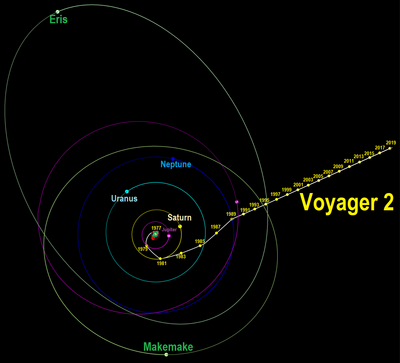 Path viewed from above the Solar System | 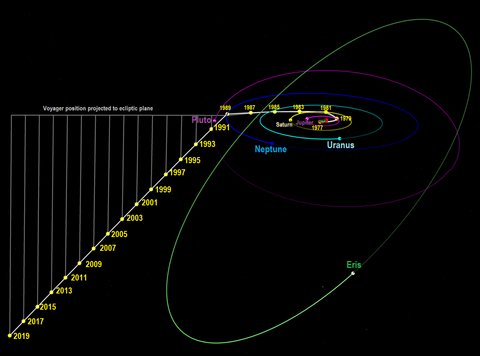 Path viewed from side, showing distance below ecliptic in gray |
| Timeline of travel | |||||||||||||||||||||||||||||||||||||||||||||||
|---|---|---|---|---|---|---|---|---|---|---|---|---|---|---|---|---|---|---|---|---|---|---|---|---|---|---|---|---|---|---|---|---|---|---|---|---|---|---|---|---|---|---|---|---|---|---|---|
| Date | Event | ||||||||||||||||||||||||||||||||||||||||||||||
| 1977-08-20 | Spacecraft launched at 14:29:00 UTC. | ||||||||||||||||||||||||||||||||||||||||||||||
| 1977-12-10 | Entered asteroid belt. | ||||||||||||||||||||||||||||||||||||||||||||||
| 1977-12-19 | Voyager 1 overtakes Voyager 2. (see diagram) | ||||||||||||||||||||||||||||||||||||||||||||||
| 1978-06 | Primary radio receiver fails. The remainder of the mission flown using backup. | ||||||||||||||||||||||||||||||||||||||||||||||
| 1978-10-21 | Exited asteroid belt | ||||||||||||||||||||||||||||||||||||||||||||||
| 1979-04-25 | Start Jupiter observation phase
| ||||||||||||||||||||||||||||||||||||||||||||||
| 1981-06-05 | Start Saturn observation phase.
| ||||||||||||||||||||||||||||||||||||||||||||||
| 1985-11-04 | Start Uranus observation phase.
| ||||||||||||||||||||||||||||||||||||||||||||||
| 1987-08-20 | 10 years of continuous flight and operation at 14:29:00 UTC. | ||||||||||||||||||||||||||||||||||||||||||||||
| 1989-06-05 | Start Neptune observation phase.
| ||||||||||||||||||||||||||||||||||||||||||||||
| 1989-10-02 | Begin Voyager Interstellar Mission. | ||||||||||||||||||||||||||||||||||||||||||||||
| Interstellar phase[27][28][29] | |||||||||||||||||||||||||||||||||||||||||||||||
| 1997-08-20 | 20 years of continuous flight and operation at 14:29:00 UTC. | ||||||||||||||||||||||||||||||||||||||||||||||
| 1998-11-13 | Terminate scan platform and UV observations. | ||||||||||||||||||||||||||||||||||||||||||||||
| 2007-08-20 | 30 years of continuous flight and operation at 14:29:00 UTC. | ||||||||||||||||||||||||||||||||||||||||||||||
| 2007-09-06 | Terminate data tape recorder operations. | ||||||||||||||||||||||||||||||||||||||||||||||
| 2008-02-22 | Terminate planetary radio astronomy experiment operations. | ||||||||||||||||||||||||||||||||||||||||||||||
| 2011-11-07 | Switch to backup thrusters to conserve power[30] | ||||||||||||||||||||||||||||||||||||||||||||||
| 2017-08-20 | 40 years of continuous flight and operation at 14:29:00 UTC. | ||||||||||||||||||||||||||||||||||||||||||||||
| 2018-11-05 | Crossed the heliopause and entered interstellar space. | ||||||||||||||||||||||||||||||||||||||||||||||
| 2023-07-18 | Voyager 2 overtook Pioneer 10 as the second farthest spacecraft from the Sun.[31][32] | ||||||||||||||||||||||||||||||||||||||||||||||
Launch and trajectory
The Voyager 2 probe was launched on August 20, 1977, by NASA from Space Launch Complex 41 at Cape Canaveral, Florida, aboard a Titan IIIE/Centaur launch vehicle. Two weeks later, the twin Voyager 1 probe was launched on September 5, 1977. However, Voyager 1 reached both Jupiter and Saturn sooner, as Voyager 2 had been launched into a longer, more circular trajectory.
- Voyager 2 launch on August 20, 1977, with a Titan IIIE/Centaur
- Trajectory of Voyager 2 primary mission
- Plot of Voyager 2's heliocentric velocity against its distance from the Sun, illustrating the use of gravity assists to accelerate the spacecraft by Jupiter, Saturn and Uranus. To observe Triton, Voyager 2 passed over Neptune's north pole, resulting in an acceleration out of the plane of the ecliptic, and, as a result, a reduced velocity relative to the Sun.[33]
Voyager 1's initial orbit had an aphelion of 8.9 AU (830 million mi; 1.33 billion km), just a little short of Saturn's orbit of 9.5 AU (880 million mi; 1.42 billion km). Voyager 2's initial orbit had an aphelion of 6.2 AU (580 million mi; 930 million km), well short of Saturn's orbit.[34]
In April 1978, a complication arose when no commands were transmitted to Voyager 2 for a period of time, causing the spacecraft to switch from its primary radio receiver to its backup receiver.[35] Sometime afterwards, the primary receiver failed altogether. The backup receiver was functional, but a failed capacitor in the receiver meant that it could only receive transmissions that were sent at a precise frequency, and this frequency would be affected by the Earth's rotation (due to the Doppler effect) and the onboard receiver's temperature, among other things.[36][37] For each subsequent transmission to Voyager 2, it was necessary for engineers to calculate the specific frequency for the signal so that it could be received by the spacecraft.
Encounter with Jupiter
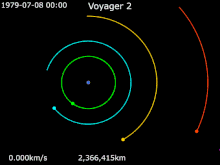
Voyager 2 · Jupiter · Io · Europa · Ganymede · Callisto
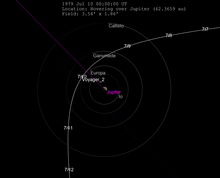
Voyager 2's closest approach to Jupiter occurred at 22:29 UT on July 9, 1979.[38] It came within 570,000 km (350,000 mi) of the planet's cloud tops.[39]Jupiter's Great Red Spot was revealed as a complex storm moving in a counterclockwise direction. Other smaller storms and eddies were found throughout the banded clouds.
Voyager 2 returned images of Jupiter, as well as its moons Amalthea, Io, Callisto, Ganymede, and Europa.[38] During a 10-hour "volcano watch", it confirmed Voyager 1's observations of active volcanism on the moon Io, and revealed how the moon's surface had changed in the four months since the previous visit.[38] Together, the Voyagers observed the eruption of nine volcanoes on Io, and there is evidence that other eruptions occurred between the two Voyager fly-bys.[40]
Jupiter's moon Europa displayed a large number of intersecting linear features in the low-resolution photos from Voyager 1. At first, scientists believed the features might be deep cracks, caused by crustal rifting or tectonic processes. Closer high-resolution photos from Voyager 2, however, were puzzling: the features lacked topographic relief, and one scientist said they "might have been painted on with a felt marker".[40] Europa is internally active due to tidal heating at a level about one-tenth that of Io. Europa is thought to have a thin crust (less than 30 km (19 mi) thick) of water ice, possibly floating on a 50 km (31 mi)-deep ocean.
Two new, small satellites, Adrastea and Metis, were found orbiting just outside the ring.[40] A third new satellite, Thebe, was discovered between the orbits of Amalthea and Io.[40]
- The Great Red Spot photographed during the Voyager 2 flyby of Jupiter
- A color mosaic of Europa
- A color mosaic of Ganymede
- Callisto photographed at a distance of 1 million kilometers
- One faint ring of Jupiter photographed during the flyby
- Atmospheric eruptive event on Jupiter
Encounter with Saturn
The closest approach to Saturn occurred at 03:24:05 UT on August 26, 1981.[41]
When Voyager 2 passed behind Saturn, viewed from Earth, it utilized its radio link to investigate Saturn's upper atmosphere, gathering data on both temperature and pressure. In the highest regions of the atmosphere, where the pressure was measured at 70 mbar (1.0 psi),[42] Voyager 2 recorded a temperature of 82 K (−191.2 °C; −312.1 °F). Deeper within the atmosphere, where the pressure was recorded to be 1,200 mbar (17 psi), the temperature rose to 143 K (−130 °C; −202 °F).[42] The spacecraft also observed that the north pole was approximately 10 °C (18 °F) cooler at 100 mbar (1.5 psi) than mid-latitudes, a variance potentially attributable to seasonal shifts[42] (see also Saturn Oppositions).
After its Saturn fly-by, Voyager 2's scan platform experienced an anomaly causing its azimuth actuator to seize. This malfunction led to some data loss and posed challenges for the spacecraft's continued mission. The anomaly was traced back to a combination of issues, including a design flaw in the actuator shaft bearing and gear lubrication system, corrosion, and debris build-up. While overuse and depleted lubricant were factors,[43] other elements, such as dissimilar metal reactions and a lack of relief ports, compounded the problem. Engineers on the ground were able to issue a series of commands, rectifying the issue to a degree that allowed the scan platform to resume its function. Subsequently, Voyager 2 proceeded with its mission to explore the Uranian system.[44]
- Voyager 2 Saturn approach view
- North, polar region of Saturn imaged in orange and UV filters
- Color image of Enceladus showing terrain of widely varying ages
- Cratered surface of Tethys at 594,000 km
- Atmosphere of Titan imaged from 2.3 million km
- Titan occultation of the Sun from 0.9 million km
- Two-toned Iapetus, August 22, 1981
- "Spoke" features observed in the rings of Saturn
Encounter with Uranus
The closest approach to Uranus occurred on January 24, 1986, when Voyager 2 came within 81,500 km (50,600 mi) of the planet's cloudtops.[45] Voyager 2 also discovered 11 previously unknown moons: Cordelia, Ophelia, Bianca, Cressida, Desdemona, Juliet, Portia, Rosalind, Belinda, Puck and Perdita.[A] The mission also studied the planet's unique atmosphere, caused by its axial tilt of 97.8°; and examined the Uranian ring system.[45] The length of a day on Uranus as measured by Voyager 2 is 17 hours, 14 minutes.[45] Uranus was shown to have a magnetic field that was misaligned with its rotational axis, unlike other planets that had been visited to that point,[46][49] and a helix-shaped magnetic tail stretching 10 million kilometers (6 million miles) away from the Sun.[46]
When Voyager 2 visited Uranus, much of its cloud features were hidden by a layer of haze; however, false-color and contrast-enhanced images show bands of concentric clouds around its south pole.[46] This area was also found to radiate large amounts of ultraviolet light, a phenomenon that is called "dayglow". The average atmospheric temperature is about 60 K (−351.7 °F; −213.2 °C). The illuminated and dark poles, and most of the planet, exhibit nearly the same temperatures at the cloud tops.
Detailed images from Voyager 2's flyby of the Uranian moon Miranda showed huge canyons made from geological faults.[46] One hypothesis suggests that Miranda might consist of a reaggregation of material following an earlier event when Miranda was shattered into pieces by a violent impact.[46]
Voyager 2 discovered two previously unknown Uranian rings.[46][47] Measurements showed that the Uranian rings are different from those at Jupiter and Saturn. The Uranian ring system might be relatively young, and it did not form at the same time that Uranus did. The particles that make up the rings might be the remnants of a moon that was broken up by either a high-velocity impact or torn up by tidal effects.
In March 2020, NASA astronomers reported the detection of a large atmospheric magnetic bubble, also known as a plasmoid, released into outer space from the planet Uranus, after reevaluating old data recorded during the flyby.[50][51]
Encounter with Neptune
Following a mid-course correction in 1987, Voyager 2's closest approach to Neptune occurred on August 25, 1989.[52][53][54] Through repeated computerized test simulations of trajectories through the Neptunian system conducted in advance, flight controllers determined the best way to route Voyager 2 through the Neptune-Triton system. Since the plane of the orbit of Triton is tilted significantly with respect to the plane of the ecliptic, through mid-course corrections, Voyager 2 was directed into a path about 4,950 km (3,080 mi) above the north pole of Neptune.[55][56] Five hours after Voyager 2 made its closest approach to Neptune, it performed a close fly-by of Triton, the larger of Neptune's two originally known moons, passing within about 40,000 km (25,000 mi).[55]
Voyager 2 discovered previously unknown Neptunian rings,[57] and confirmed six new moons: Despina, Galatea, Larissa, Proteus, Naiad and Thalassa.[58][B] While in the neighborhood of Neptune, Voyager 2 discovered the "Great Dark Spot", which has since disappeared, according to observations by the Hubble Space Telescope.[59] The Great Dark Spot was later hypothesized to be a region of clear gas, forming a window in the planet's high-altitude methane cloud deck.[60]
- Voyager 2 image of Neptune
- Despina as imaged from Voyager 2
- Cratered surface of Larissa
- Dark surface of Proteus
- Color mosaic of Voyager 2 Triton
- Cirrus clouds imaged above gaseous Neptune
- Rings of Neptune taken in occultation from 280,000 km
Interstellar mission
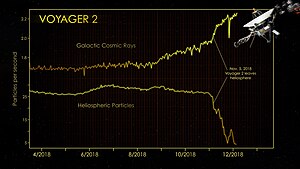
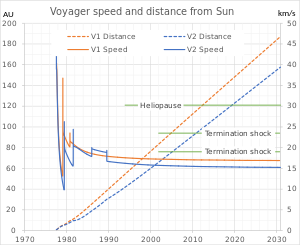

Once its planetary mission was over, Voyager 2 was described as working on an interstellar mission, which NASA is using to find out what the Solar System is like beyond the heliosphere. As of September 2023[update] Voyager 2 is transmitting scientific data at about 160 bits per second.[61] Information about continuing telemetry exchanges with Voyager 2 is available from Voyager Weekly Reports.[62]

In 1992, Voyager 2 observed the nova V1974 Cygni in the far-ultraviolet.[63]
In July 1994, an attempt was made to observe the impacts from fragments of the comet Comet Shoemaker–Levy 9 with Jupiter.[63] The craft's position meant it had a direct line of sight to the impacts and observations were made in the ultraviolet and radio spectrum.[63] Voyager 2 failed to detect anything, with calculations showing that the fireballs were just below the craft's limit of detection.[63]
On November 29, 2006, a telemetered command to Voyager 2 was incorrectly decoded by its on-board computer—in a random error—as a command to turn on the electrical heaters of the spacecraft's magnetometer. These heaters remained turned on until December 4, 2006, and during that time, there was a resulting high temperature above 130 °C (266 °F), significantly higher than the magnetometers were designed to endure, and a sensor rotated away from the correct orientation.[64] As of this date[when?] it had not been possible to fully diagnose and correct for the damage caused to Voyager 2's magnetometer, although efforts to do so were proceeding.[65][failed verification]
On August 30, 2007, Voyager 2 passed the termination shock and then entered into the heliosheath, approximately 1 billion mi (1.6 billion km) closer to the Sun than Voyager 1 did.[66] This is due to the interstellar magnetic field of deep space. The southern hemisphere of the Solar System's heliosphere is being pushed in.[67]
On April 22, 2010, Voyager 2 encountered scientific data format problems.[68] On May 17, 2010, JPL engineers revealed that a flipped bit in an on-board computer had caused the problem, and scheduled a bit reset for May 19.[69] On May 23, 2010, Voyager 2 resumed sending science data from deep space after engineers fixed the flipped bit.[70] Currently[as of?] research is being done regarding marking the area of memory with the flipped bit off limits or disallowing its use. The Low-Energy Charged Particle Instrument is currently operational, and data from this instrument concerning charged particles is being transmitted to Earth. This data permits measurements of the heliosheath and termination shock. There has also been a modification to the on-board flight software to delay turning off the AP Branch 2 backup heater for one year. It was scheduled to go off February 2, 2011 (DOY 033, 2011–033).
On November 7, 2012, Voyager 2 reached 100 AU (9.3 billion mi; 15 billion km) from the Sun, making it the third human-made object to reach that distance and the second that was still sending data to Earth at that distance. Voyager 1 was 122 AU (11.3 billion mi; 18.3 billion km) from the Sun, and Pioneer 10 is presumed to be at 107 AU (9.9 billion mi; 16.0 billion km). While Pioneer has ceased communications, both the Voyager spacecraft are performing well and are still communicating.
It was originally thought that Voyager 2 would enter interstellar space in early 2016, with its plasma spectrometer providing the first direct measurements of the density and temperature of the interstellar plasma.[71] In December 2018, the Voyager project scientist, Edward C. Stone, announced that Voyager 2 reached interstellar space on November 5, 2018.[9][10]
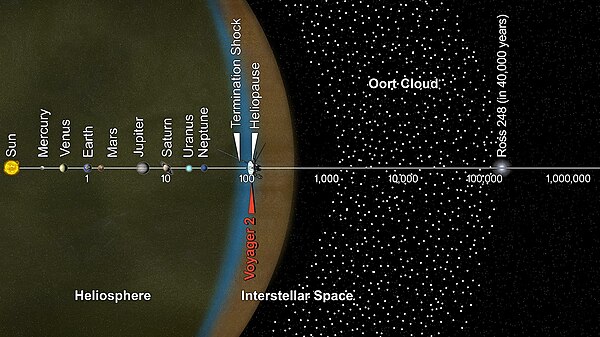
Maintenance to the Deep Space Network cut outbound contact with the probe for eight months in 2020. Contact was reestablished on November 2, when a series of instructions was transmitted, subsequently executed, and relayed back with a successful communication message.[72] On February 12, 2021, full communications were restored after a major ground station antenna upgrade that took a year to complete.[13]
In October 2020, astronomers reported a significant unexpected increase in density in the space beyond the Solar System as detected by the Voyager 1 and Voyager 2; this implies that "the density gradient is a large-scale feature of the VLISM (very local interstellar medium) in the general direction of the heliospheric nose".[73][74]
On July 18, 2023, Voyager 2 overtook Pioneer 10 as the second farthest spacecraft from the Sun.[75][76]
On July 21, 2023, a programming error misaligned Voyager 2's high gain antenna[77] 2 degrees away from Earth, breaking communications with the spacecraft. By August 1, the spacecraft's carrier signal was detected using multiple antennas of the Deep Space Network.[78][79] A high-power "shout" on August 4 sent from the Canberra station[80] successfully commanded the spacecraft to reorient towards Earth, resuming communications.[79][81] As a failsafe measure, the probe is also programmed to autonomously reset its orientation to point towards Earth, which would have occurred by October 15.
Reductions in capabilities
As the power from the RTG slowly reduces, various items of equipment have been turned off on the spacecraft.[82] The first science equipment turned off on Voyager 2 was the PPS in 1991, which saved 1.2 watts.[82]
| Year | End of specific capabilities as a result of the available electrical power limitations[83] |
|---|---|
| 1998 | Termination of scan platform and UVS observations |
| 2007 | Termination of Digital Tape Recorder (DTR) operations (It was no longer needed due to a failure on the High Waveform Receiver on the Plasma Wave Subsystem (PWS) on June 30, 2002.)[84] |
| 2008 | Power off Planetary Radio Astronomy Experiment (PRA) |
| 2016 approx | Termination of gyroscopic operations |
| 2019 | CRS heater turned off[85] |
| 2020 approx | Initiate instrument power sharing |
| 2021 | Turn off heater for Low Energy Charged Particle instrument[86] |
| 2023 | Software update reroutes power from the voltage regulator to keep the science instruments operating[87] |
| 2030 approx | Can no longer power any instrument[88] |
| 2036 | Out of range of the Deep Space Network |
Concerns with the orientation thrusters
Some thrusters needed to control the correct attitude of the spacecraft and to point its high-gain antenna in the direction of Earth are out of use due to clogging problems in their hydrazine injector. The spacecraft no longer has backups available for its thruster system and "everything onboard is running on single-string" as acknowledged by Suzanne Dodd, Voyager project manager at JPL, in an interview with Ars Technica.[89] NASA has decided to patch the computer software in order to modify the functioning of the remaining thrusters to slow down the clogging of the small diameter hydrazine injector jets. Before uploading the software update on the Voyager 1 computer, NASA will first try the procedure with Voyager 2, which is closer to Earth.[89]
Future of the probe
The probe is expected to keep transmitting weak radio messages until at least the mid-2020s, more than 48 years after it was launched.[90]
Voyager 2 is not headed toward any particular star, although in roughly 42,000 years, it will pass the star Ross 248 at a distance of 1.7 light-years.[91][92] If undisturbed for 296,000 years, Voyager 2 should pass by the star Sirius at a distance of 4.3 light-years.[93]
Golden record
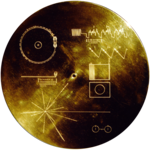
Both Voyager space probes carry a gold-plated audio-visual disc, a compilation meant to showcase the diversity of life and culture on Earth in the event that either spacecraft is ever found by any extraterrestrial finders.[94][95] The record, made under the direction of a team including Carl Sagan and Timothy Ferris, includes photos of the Earth and its lifeforms, a range of scientific information, spoken greetings from people such as the Secretary-General of the United Nations and the President of the United States and a medley, "Sounds of Earth", that includes the sounds of whales, a baby crying, waves breaking on a shore, and a collection of music spanning different cultures and eras including works by Wolfgang Amadeus Mozart, Blind Willie Johnson, Chuck Berry and Valya Balkanska. Other Eastern and Western classics are included, as well as performances of indigenous music from around the world. The record also contains greetings in 55 different languages.[96] The project aimed to portray the richness of life on Earth and stand as a testament to human creativity and the desire to connect with the cosmos.[95][97]
See also
Notes
References
Further reading
- "Saturn Science Results". Voyager Science Results at Saturn. Retrieved February 8, 2005.
- "Uranus Science Results". Voyager Science Results at Uranus. Retrieved February 8, 2005.
- Nardo, Don (2002). Neptune. Thomson Gale. ISBN 0-7377-1001-2
- JPL Voyager Telecom Manual
External links

